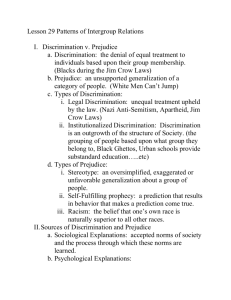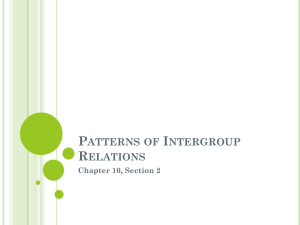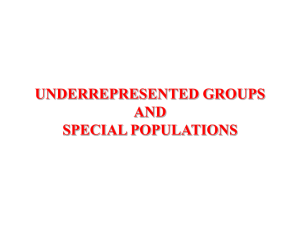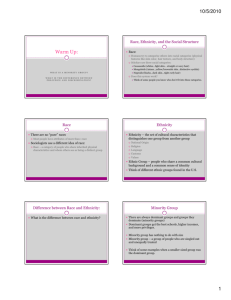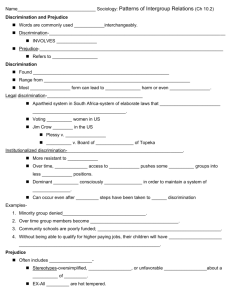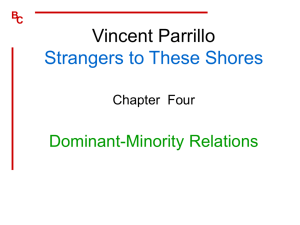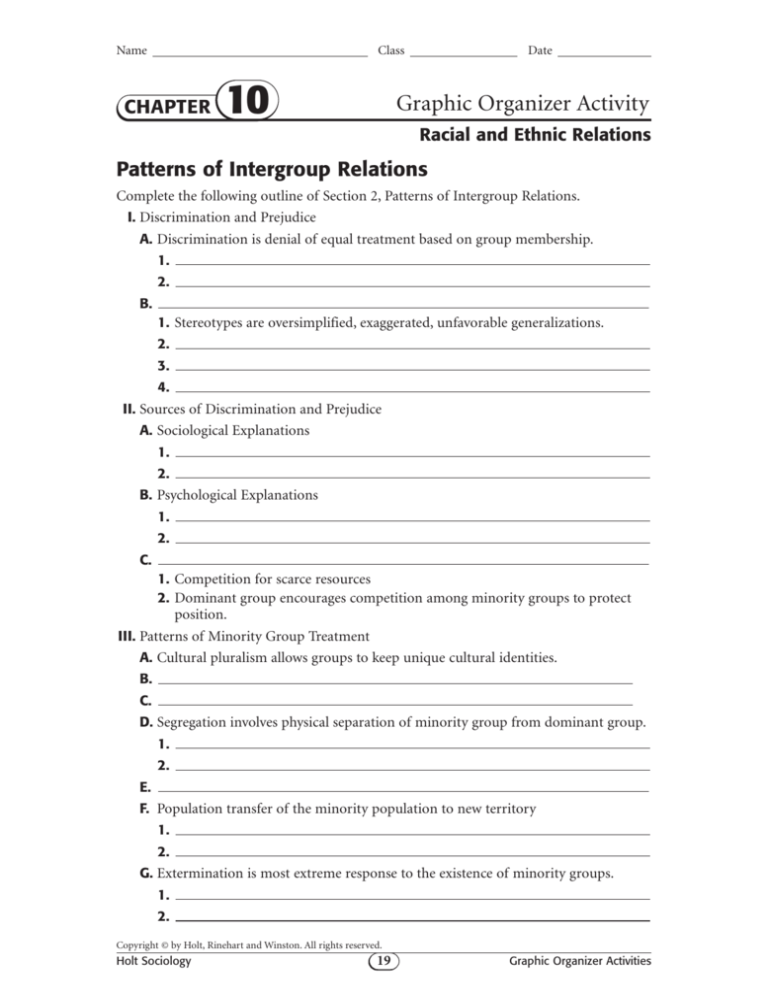
Name
CHAPTER
Class
10
Date
Graphic Organizer Activity
Racial and Ethnic Relations
Patterns of Intergroup Relations
Complete the following outline of Section 2, Patterns of Intergroup Relations.
I. Discrimination and Prejudice
A. Discrimination is denial of equal treatment based on group membership.
1.
2.
B.
1. Stereotypes are oversimplified, exaggerated, unfavorable generalizations.
2.
3.
4.
II. Sources of Discrimination and Prejudice
A. Sociological Explanations
1.
2.
B. Psychological Explanations
1.
2.
C.
1. Competition for scarce resources
2. Dominant group encourages competition among minority groups to protect
position.
III. Patterns of Minority Group Treatment
A. Cultural pluralism allows groups to keep unique cultural identities.
B.
C.
D. Segregation involves physical separation of minority group from dominant group.
1.
2.
E.
F. Population transfer of the minority population to new territory
1.
2.
G. Extermination is most extreme response to the existence of minority groups.
1.
2.
Copyright © by Holt, Rinehart and Winston. All rights reserved.
Holt Sociology
19
Graphic Organizer Activities
CHAPTER
10
Graphic Organizer: Possible Solutions
Racial and Ethnic Relations
Patterns of Intergroup Relations
Complete the following outline of Section 2, Patterns of Intergroup Relations.
I. Discrimination and Prejudice
A. Discrimination is denial of equal treatment based on group membership.
1. Legal discrimination is upheld by law.
2. Institutionalized discrimination is part of the social structure.
B. Prejudice is an unsupported generalization about a category of people.
1. Stereotypes are oversimplified, exaggerated, unfavorable generalizations.
2. Stereotypes can become self-fulfilling prophesies.
3. Racism is a belief that one’s own race or ethnic group is superior to others.
4. Merton: active bigot, timid bigot, fair-weather liberal, all-weather liberal.
II. Sources of Discrimination and Prejudice
A. Sociological Explanations
1. Prejudice may be embedded in the social norms of a society or group.
2. People become prejudiced by internalizing these norms.
B. Psychological Explanations
1. Adorno: authoritarian personality
2. Frustration and anger may lead to scapegoating—blaming innocent people.
C. Economic Explanations
1. Competition for scarce resources
2. Dominant group encourages competition among minority groups to protect
position.
III. Patterns of Minority Group Treatment
A. Cultural pluralism allows groups to keep unique cultural identities.
B. Assimilation blends groups into a single group with a common culture and identity.
C. Legal protection may protect rights of minority groups.
D. Segregation involves physical separation of minority group from dominant group.
1. De jure segregation based on laws
2. De facto segregation based on informal norms
E. Subjugation is maintaining control over group through force, including slavery.
F. Population transfer of the minority population to new territory
1. Indirect transfer: dominant group makes minority miserable so they leave
2. Direct transfer: forcibly moving group to new location
G. Extermination is most extreme response to the existence of minority groups.
1. Genocide is the attempt to destroy the entire targeted population.
2. Ethnic cleansing is removing a group through terror, expulsion, and mass murder.
Copyright © by Holt, Rinehart and Winston. All rights reserved.
Holt Sociology
20
Graphic Organizer Activities

